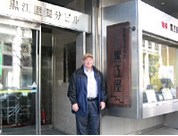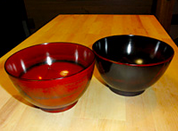 |
  セインさん、今日おうかがいするのは、漆器の老舗「黒江屋」さんです。 セインさん、今日おうかがいするのは、漆器の老舗「黒江屋」さんです。
Thayne-san, today we’re going to visit Kuroeya, a long-established lacquer ware company. . |
 |
お店が入っているビルは、日本橋の真ん前。すごいロケーションにあるんですね!
The shop is located in a building in the middle of Nihonbashi. It’s an incredible location! |
|
|
 |
まずは1階の入口横にあるショーウインドーをちょっと見てください。
Let’s have a look at the show window at the first-floor entrance. |
|
|
 |
何ですか?! これ。
What could this be? |
|
|
 |
昔の日本橋の欄干をかざっていた擬宝珠(ぎぼし)です。実は、現在の日本橋は20代目で、今年ちょうど100歳を迎えたんですが、これは350年ほど前の橋につけられていたものだそうです。
This is an ornament that was displayed on the railing of the Nihonbashi bridge. The current Nihonbashi bridge is the 20th and it’s almost exactly 100-years old. The ornament was on the bridge that stood about 350 years ago.
ショーケースに展示されている擬宝珠。万治元年(1658)の刻印がある。なお、日本橋1丁目の町会では、これを写した擬宝珠を乗せた神輿があり、一般的な鳳凰の神輿と交互に繰り出している。
The ornament displayed in the showcase, marked with the date “First Year of Manji Era” (1658). The merchants association of Nihonbashi 1 Chome have a mikoshi with this ornament engraved on it, and it is used alternately with the regular mikoshi with a phoenix on it. |
|
|
| (柏原) |
ようこそ、セインさん。黒江屋の柏原孫左衛門です。
Thanks for coming, Thayne-san. My name is Magozaemon Kashiwara of Kuroeya. |
|
|
 |
こんにちは、柏原さん、セインです。今ちょうど、お宝を見せていただいていたところです。黒江屋さんは、ものすごく長い歴史のあるお店なんですね。
Hello, Kashiwara-san. We were just looking at all your treasures. Kuroeya really does have a long history, doesn’t it? |
|
|
| (柏原) |
黒江屋の創業は元禄2年(1689)ですから、320年ほど前のことになります。紀伊の国(現在の和歌山県)の黒江村という漆器の産地から江戸に出てき て、日本橋本町4丁目に店を構えたのが始まりです。ところが、85年後の安永3年(1774)に諸事情があって故郷に帰られることになって、私ども柏原家 が経営権を引き継いだのです。
Kuroeya was established in 1689, so that was 320 years ago. We originated in a village in Kii (modern-day Wakayama prefecture) known for lacquer ware and then moved to Tokyo and set up shop in Nihonbashi Honcho 4 Chome. In 1774, three years after coming to Tokyo, the original company moved back to Kii for various reasons, and the business was carried on by the Kashiwara family. |
|
|
 |
えっ? ということは、柏原家は、黒江屋さんとは別のお店をやっていたということですか?
Oh, really? So you mean the Kashiwara family had another shop besides the Kuroeya? |
|
|
| (柏原) |
はい。柏原家は、黒江屋よりもさらに古く、寛永年間(1624~1645)に京都で創業して、「柏屋」の屋号で呉服や小間物を扱っておりました。江戸にも 木綿問屋として日本橋本町に店を構えていたんです。ですから、黒江屋の経営を引き継いで、家業の一つに漆器販売が加わった、というわけです。
Yes. The Kashiwara business was established even before Kuroeya in the Kanei period (1624 to 1645) in Kyoto. They sold clothes and daily necessities under the name of Kashiya. During the Edo period, we had a shop in Nihonbashi Honcho as a cotton wholesaler. We continued on the Kuroeya business and sold lacquer ware as part of the family business. |
|
|
 |
つまり、最近の言葉で言うと、M&Aですね。 それにしても、もともとは京都のお店なんですか。
So, that was kind of like a joint venture, right? But you were originally a Kyoto business? |
|
|
| (柏原) |
ええ。江戸は何もない湿地帯を埋め立てながら造っていった新しい街ですから、産業もなければ商人もいなかった。ですから、京都や大阪、近江、伊勢などの商人が品物を作らせたり、仕入れたりして江戸に出した店「江戸店(えどだな)」に送り、売ったんです。 つまり、江戸にいるのは関西から派遣された従業員さん。主人はいません。うちの場合も、当主が東京に住むようになったのは先代からなんです。
Yes, Edo (current Tokyo) was a new city made by reclaiming the wetland area, and so there were no businesses or merchants. So merchants in Kyoto, Osaka, Omi, Ise and other parts of Japan had things made and delivered to them to be sold at their shops in Edo. So the merchants in Edo were mainly employees sent from the Kansai area. The owners didn’t come here. Only one generation ago did the head of our company move to Tokyo. |
|
|
 |
そうなんですか。
Oh, I see. |
|
|
 |
セインさん。京都にある柏原家の邸宅は、「洛東遺芳館(らくとういほうかん)」という美術館になっていて、春と秋の2回、一般公開されているんですよ。豪 華な婚礼道具や浮世絵などのコレクションが人気で、期間中はたくさんの観光客が訪れるんですが、お屋敷そのものも素晴らしいんです。
Thayne-san, you might be interested to know that at the old Kashiwara family home in Kyoto, we have a museum called the Rakutoihokan with public exhibitions twice a year in the spring and autumn. The collection of colorful wedding-ceremony items, ukiyoe paintings and other items are quite popular. During the exhibitions, we have a lot of visitors―the building itself is quite impressive. |
|
|
| (柏原) |
運よく火事に遭わなかったので、今も数百年前の商家の体裁を保っているんです。セインさんもぜひ一度、どうぞ。
Fortunately, it avoided fire over the years, so you can still see a traditional merchant home from hundreds of years ago. I hope you get a chance to see it. |
|
|
 |
ありがとうございます。いつか、ぜひ! 何百年もファミリー企業で続いていて、しかも創業当時からの家がまだ残っているなんて、欧米ではほとんど考えられませんから興味があります。それにしても、400年近くもこうして家業が続いているのには、何か秘訣があるんですか。
Thank you. I’d love to see it! In the West, we almost never see family companies stay in operations for hundreds of years―and with the old family home still standing. Could you tell me what your secret is for keeping the family business going for almost 400 years? |
|
|
| (柏原) |
一つは、『別家制度』だと思います。別家というのは、従業員の最高位で、今でいう取締役ですが、終生、店を盛り立てていくことを誓う一方で、主人がだらしがなければ遠慮なくいさめる役割もするというのが「別家制度」なんです。
One reason is the bekke system (separate-house system). Under this system, the top, or what would be the company executives today, would promise to continuously work to make the shop flourish, while also having the responsibility to admonish the company head if he doesn’t do a good job. |
|
|
 |
単なる主従関係じゃないんですね。
So it’s not a simple employee-employer relationship, then? |
|
|
| (柏原) |
ええ。ですから、男子が授からなくて養子をもらったものの、そのお婿さんに能力がないということで、別家が離縁させたという例まであるんです。
それから、店が続いてきたもう一つの理由が「倹約令」かと思います。資料が残っているんですが、食事の質・量や風呂に入る回数などの暮らしに関わる約束事から、交際費の制限や家普請の停止まで、細かく規定して、主従ともに倹約を促しています。
倹約令はこれまでに10回ほど出されているんですが、火事のあとや不景気の時に出されたほか、幕府に厖大な御用金を収奪された時などにも3回出されています。
Right. There have even been cases where a man, after taking on the family name of his bride and running the business, was forced by the bekke to get divorced for not having the needed skills.
Another reason we’ve lasted was something called the Rules of Frugality. We still have the old documents that give rules dealing with the type and amount of food to eat, the frequency of bathing, and other parts of daily life. There are even detailed rules for both employers and employees concerning entertainment expenses, and how much money can be spent on building a house. The Rules of Frugality have been issued ten times over the years, including three times when there was a fire, during a recession, and when the government demanded a large payment. |
|
|
  |
へえ!! 時代劇では話に出てきますが、本当に幕府にお金を取られた話は初めて聞きました。やっぱり歴史の店ですね。
Interesting! I knew about demands from the government for payment from historical dramas, but this is the first I heard about it actually happening. You do have a long history. |
|
|
 |
ところで、柏原家では江戸から明治にかけて、木綿と漆器の二本柱で事業を続けられていますが、やがて家業の中心が紙に移って、現在に続いているんですね。
Now I heard that the Kashiwara family worked in the cotton and lacquer ware business from the Edo period into the Meiji period, and eventually your main business became paper, which continues now. |
|
|
| (柏原) |
ええ。江戸時代に店を大きくしてくれた木綿は、だんだんはやらなくなって明治の終わりにはほとんどやめていきましたし、漆器も戦後、日本人の生活スタイル が変わって、大きく需要が減ってきています。昔は、座敷机、ちゃぶ台、お膳、お盆、汁椀、箸……と、生活のなかで、たくさんの漆製品が使われていたんです が。
That’s true. During the Edo period, it was the cotton business that helped us grow, but that slowed down and we were basically out of the business at the end of the Meiji period. Then after World War II, demand for lacquer ware dropped because of the change in lifestyle. In the past, lacquer ware was commonly used for Japanese-room desks, short-legged tables, serving utensils, trays, bowls, chopsticks, all kinds of items. |
|
|
 |
買う人がいないと、お店が困るだけでなく、それを作って生計を立てていた人たちが困りますね。
So when people stopped buying it, it’s not only the shops that suffer, but also those that survive by making the items. |
|
|
| (柏原) |
はい。ですから職人さんがどんどん減っています。そして高齢化している……。とても残念です。
でも、漆は堅牢で美しい、素晴らしい天然の塗料です。そして、その自然素材に人の手が加わって作り上げられる素晴らしい工芸品です。ですから、家業のな かでの漆器の売り上げ割合は昔に比べると小さくはなっていますが、私は漆器を家業の一つとしていることを誇りに思っていますし、日本の伝統文化を守る仕事 をさせてもらっていることを本当に幸せだと思っているんです。漆器の魅力をもっともっとたくさんの人に知っていただきたいし、世界中の方に使っていただき たいと思っています。
True. So the number of craftsmen is declining. And they’re getting older. It’s quite unfortunate.
But lacquer ware is strong and beautiful, and it’s made with wonderful natural materials. When the skill of a craftsman is applied to these natural materials, the result is a beautiful work of art. So, although the ratio of lacquer ware in our business grows smaller, we are very proud to have lacquer ware as a part of our business. We are extremely happy to be able to play a role in preserving the traditional culture of Japan. We want to share the charm of Japanese lacquer ware with more and more people all over the world. |
|
|
 |
昔から漆器っていいなあと思っていたんですが、今のお話を聞いて、いよいよ好きになりました。
I’ve been interested in lacquer ware from Japan for a long time, but now I realize just how special it is. |
|
|
  |
今日は、ありがとうございました。 Thank you for your time today. |
|
 |
|
(文)太田美代 (英訳)デイビッド・A・セイン |



 セインさん、今日おうかがいするのは、漆器の老舗「黒江屋」さんです。
セインさん、今日おうかがいするのは、漆器の老舗「黒江屋」さんです。





